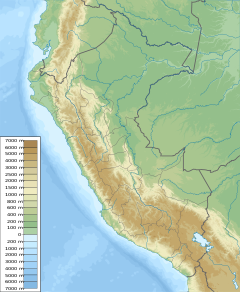Ticsani
| Ticsani | |
|---|---|
 The Ticsani lava dome complex (center) | |
| Highest point | |
| Elevation | 5,408 m (17,743 ft)[1] |
| Coordinates | 16°45′18″S 70°35′42″W / 16.755°S 70.595°W[1] |
| Geography | |
| Location | Moquegua Region |
| Parent range | Andes |
| Geology | |
| Mountain type | Lava domes |
| Last eruption | 1800 ± 200 years[1] |
Ticsani is a volcano in Peru northwest of
Geography and geomorphology
Ticsani is in the
Volcanism in South America occurs along its western coast and in several volcanic belts, including the
Ticsani features three
Geology
Off the southwestern coast of South America, the
Ticsani is grouped together with the neighbouring volcanoes
The basement on which these volcanoes rose includes a
Composition
The complex has erupted
Eruption history
Ticsani was active during the
Later the three
Presently,
Hazards
About 5,000 people live within 15 kilometres (9.3 mi) to Ticsani and would be threatened in the case of a future eruption, with particular hazards including ash fall, lahars, pyroclastic flows and the collapse of lava domes.[16] Large explosive events like the "Grey Ticsani" and "Brown Ticsani" eruptions ejected material mainly in north-northeastern and southeastern direction; in case of a repeat eruption the towns Calacoa, Cuchumbaya, Quebaya, San Cristóbal and Soquezane would be impacted by tephra fallout.[31] In addition to the local population, ashfall would hit major regional roads, reservoirs,[32] mines and airports.[31] Additional towns in the area include Cambrune and Carumas.[5] Pyroclastic flows are fast-moving flows of hot rock fragments and gases; at Ticsani they have reached distances of at least 5 kilometres (3.1 mi) from the volcano. A repeat of the sector collapse of the "old Ticsani" is improbable as the "modern Ticsani" is considered to be stable, but parts of the old volcano could still fail and generate lahars in the river valleys. Volcanic gases may accumulate in valleys and depressions, while lava flows are unlikely to reach large distances and are thus minor threats.[31]
The volcano is classified as being a "High Risk Volcano".
Notes
- ^ Sometimes four domes are counted, the fourth one east of the three canonical domes.[10]
- ^ The eruption has been assigned a volcanic explosivity index of 4.[19]
- ^ This eruption has been assigned a volcanic explosivity index of 2-3.[21]
References
- ^ a b c d e "Ticsani". Global Volcanism Program. Smithsonian Institution.
- ^ INGEMMET 2015, p. 4.
- ^ a b c d Byrdina et al. 2013, p. 154.
- ^ a b c d e Lavallée et al. 2009, p. 255.
- ^ a b Velarde et al. 2018, p. 3.
- S2CID 209392997.
- ^ a b Salazar & Thouret 2003, p. 3.
- ^ Igme & Edward 2020, p. 11.
- ^ a b c d e f Lavallée et al. 2009, p. 257.
- ^ a b Salazar & Thouret 2003, p. 4.
- ^ a b c d e f g "Geología del volcán Ticsani". Observatorio Vulcanológico de INGEMMET (in Spanish). INGEMMET. Retrieved 4 January 2021.
- ^ a b c Byrdina et al. 2013, p. 153.
- ^ Lavallée et al. 2009, p. 260.
- ^ Lavallée et al. 2009, p. 254.
- ^ Lavallée et al. 2009, p. 262.
- ^ a b c d Salazar & Thouret 2003, p. 2.
- ^ Salazar & Thouret 2003, p. 17.
- ^ a b Salazar & Thouret 2003, p. 8.
- ^ Salazar & Thouret 2003, p. 11.
- ^ a b c Igme & Edward 2020, p. 15.
- ^ a b Salazar & Thouret 2003, p. 12.
- ^ Igme & Edward 2020, p. 7.
- ^ "Actividad histórica del volcán Ticsani". Observatorio Vulcanológico de INGEMMET (in Spanish). INGEMMET. Retrieved 4 January 2021.
- S2CID 210131824.
- ^ Velarde et al. 2018, p. 7.
- ^ Velarde et al. 2018, p. 8.
- ISSN 0377-0273.
- ^ Igme & Edward 2020, p. 3.
- ^ INGEMMET 2015, p. 5.
- ^ Velarde et al. 2018, p. 45.
- ^ a b c "Mapa de peligro del volcán Ticsani". Observatorio Vulcanológico de INGEMMET (in Spanish). INGEMMET. Retrieved 4 January 2021.
- ^ Salazar & Thouret 2003, p. 22.
- ^ Velarde et al. 2018, p. 1.
- ^ INGEMMET 2015, p. 18.
- ^ INGEMMET 2015, p. 26.
- ^ "Reportes del volcán Ticsani" (in Spanish). Southern Volcano Observatory. Archived from the original on 8 February 2019. Retrieved 9 March 2018.
Sources
- Byrdina, S.; Ramos, D.; Vandemeulebrouck, J.; Masias, P.; Revil, A.; Finizola, A.; Gonzales Zuñiga, K.; Cruz, V.; Antayhua, Y.; Macedo, O. (March 2013). "Influence of the regional topography on the remote emplacement of hydrothermal systems with examples of Ticsani and Ubinas volcanoes, Southern Peru" (PDF). Earth and Planetary Science Letters. 365: 152–164. S2CID 9187628.
- Igme, Cruz; Edward, John (April 2020). Análisis de la actividad sísmica en el volcán Ticsani y su variación temporal, periodo 1999-2019 (Report) (in Spanish).
- INGEMMET (2015). "Monitoreo de los volcanes Coropuna, Ticsani y Tutupaca" (PDF) (in Spanish). Sistema de Información para la Gestión del Riesgo de Desastres. Retrieved 9 March 2018.
- Lavallée, Yan; de Silva, Shanaka L.; Salas, Guido; Byrnes, Jeffrey M. (October 2009). "Structural control on volcanism at the Ubinas, Huaynaputina, and Ticsani Volcanic Group (UHTVG), southern Peru". Journal of Volcanology and Geothermal Research. 186 (3–4): 253–264. ISSN 0377-0273.
- Salazar, Jersy Mariño; Thouret, Jean-Claude (2003). "Geologıa, historia eruptiva y evaluación de peligros del volcán Ticsani". Observatorio Vulcanológico del Sur (in Spanish). Sociedad Geológica del Perú. Retrieved 9 March 2018.
- Velarde, L.; Vargas, K.; Vilca, J.; Torres, José; Puma, Nino; Limachi, Nancy; Montesinos, Víctor; Malpartida, Alan; Macedo, L. (April 2018). "Estado actual de la actividad del volcán Ticsani: Resultados del monitoreo y vigilancia 2014-2018". Repositorio Institucional - IGP.

